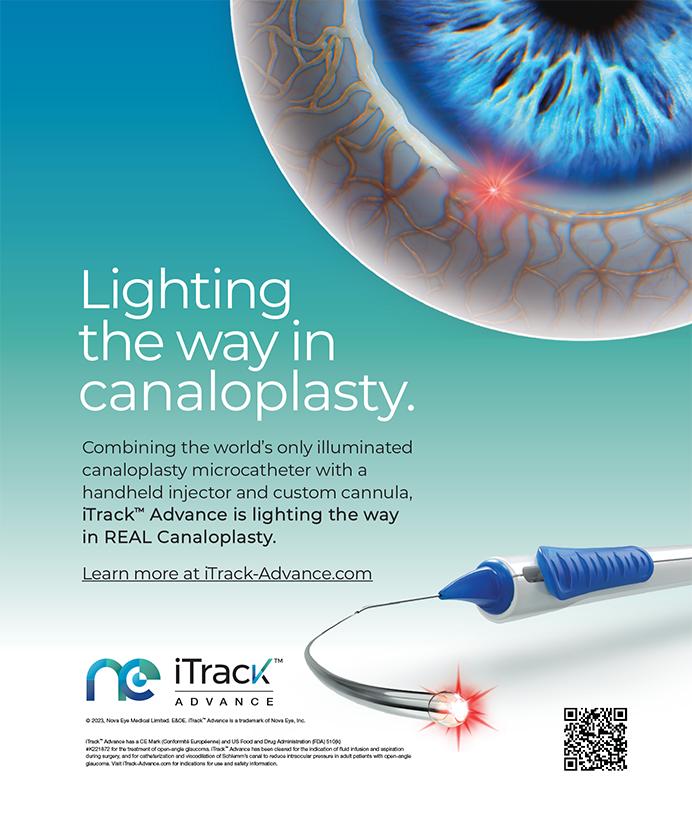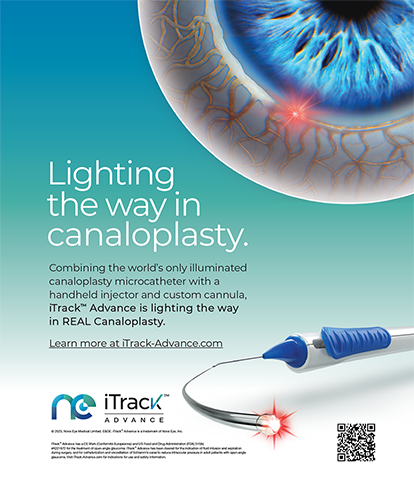During cataract surgery, careful observation of the Purkinje images, or the light reflections off the surfaces of the cornea and the lens, can reveal a significant amount of information about the optical and positional characteristics of the IOL.
In the June issue of Cataract & Refractive Surgery Today, I described a method for using Purkinje images as real-time markers of an IOL’s position. Briefly, a preoperative photograph of the undilated eye is taken, and the location of the undilated pupil center relative to the first Purkinje image (PI) is noted. Intraoperatively, the surgeon uses PI as a marker to find the location of the undilated pupillary center while working on the eye with the dilated pupil. In the July issue, I showed how surgeons can also use the third and fourth Purkinje images (PIII and PIV) intraoperatively to confirm fixation or to locate the line of sight in patients who do not fixate voluntarily.
My earlier two articles explained how to use Purkinje images as markers of the IOL’s and the eye’s positions, but they only touched on the information that these ubiquitous reflections provide about the IOL itself. When observed carefully, Purkinje images can give the surgeon insight into an IOL’s power, toricity, design, orientation, and even material.
THE PURKINJE IMAGES
I use a Lumera surgical microscope (Carl Zeiss Meditec, Inc., Dublin, CA) that projects three separate lights, so each Purkinje image is actually a triangular cluster of three lights. PI is reflected from the anterior surface of the cornea and can been seen in all figures as a small, bright, white cluster of lights near the center of the eye. The “upright” pattern has a larger light on top and two smaller lights below. Although the shape of PI varies with the shape of the cornea (and thus PI is used for keratometry and corneal topography), PI varies the least of the three Purkinje images when viewed during cataract surgery. PIII and PIV come from the anterior and posterior surfaces, respectively, of an IOL. Their appearance (size, shape, pattern, orientation, intensity, and color) are therefore affected by the IOL’s material and design, so PIII and PIV can vary widely from case to case. With a basic understanding of these variations, a surgeon can determine a lot about an IOL simply by observing its Purkinje images.
THE IOL’S POWER
The primary purpose of an IOL is to focus light with a specified spherical power. The dioptric power of an IOL is typically varied by altering the curvature of the optic’s anterior (and occasionally the posterior) surface. Several methodologies and formulas have been introduced by which to calculate the IOL’s power after taking detailed clinical or research measurements of PI, PIII, and PIV.1-6 Although accurate, these calculations can be complex and impractical for intraoperative use. Nevertheless, if a surgeon typically employs just a few types of IOLs, it will be simple for him or her to learn how PIII (and PIV) vary with power for those particular lines of lenses.
Figure 1A through 1C demonstrates a series of images of the biconvex Tecnis 1-Piece IOL (Abbott Medical Optics Inc., Santa Ana, CA), ranging in power from high (+27.00 D) to low (+8.50 D). In this series, the size of PI changes minimally, whereas the sizes of PIII and PIV change significantly. Compared with a +21.50 D lens of “average” power (Figure 1B), higherpowered IOLs have a more convex (steeper) anterior optic and an unchanged posterior optic. PIII is therefore smaller, and PIV is unchanged (Figure 1A). Contrarily, lower-powered IOLs have a less convex (flatter) anterior and posterior optic, so PIII and PIV both increase in size (Figure 1C). Moreover, as the power of the IOL decreases through the midteens, the convexity of the anterior optic continues to decrease, and PIII inverts. As the IOL’s power becomes minus, like with the Sensar IOL (Abbott Medical Optics Inc., Santa Ana, CA), the optic becomes meniscus-shaped with a convex anterior surface and a concave posterior surface. Because a minimal level of the anterior surface’s convexity is maintained, the appearance of PIII remains the same as that of a low plus-powered IOL, but the concave posterior surface results in an upright PIV (Figure 1D).
For different lenses, like the biconvex AcrySof IQ IOL (Alcon Laboratories, Inc., Fort Worth, TX) , a similar trend of PIII and PIV can be observed, but the exact appearance of these reflections is different.
TORICITY
Whereas an IOL’s power is altered primarily by changing the curvature of the anterior optic’s surface, its toricity can be varied by changing the curvature along a specified meridian on the posterior optic’s surface. The AcrySof IQ Toric IOL (SN6ATT) is an example: its altered posterior curvature affects the shape of PIV. Figure 2 shows a series of AcrySof IQ IOLs with 0, +3.00, and +5.25 D of cylindrical power. PI is clearly seen as before; PIV is yellow and larger than all but the lowest-powered Tecnis IOLs in Figure 1. PIV is yellow because light reflecting off the posterior surface of the IOL passes (twice) through the blue-light–filtering chromophore in the lens. The larger size of PIV is due to the relatively flatter posterior curvature of AcrySof IOLs compared with lenses made from the acrylic material manufactured by Abbott Medical Optics Inc. due to the AcrySof material’s higher index of refraction. PIII is not shown in these figures, because the high reflectance and the flat anterior surface of these AcrySof IOLs create an intense PIII reflection that can obscure the other Purkinje images.
Figure 2A shows an AcrySof IQ IOL with no cylindrical power. Although inverted, PIV has the same aspect ratio as PI. Figures 2B and 2C show two toric IOLs of increasing cylindrical power. The toric marking dots indicate the axis of flattening on the posterior surface, which is aligned to the steep axis of the cornea. PIV is thus stretched along the axis of the toric markings, with greater lengthening as the cylindrical power increases.
DESIGN, ORIENTATION, AND MATERIAL
Other aspects of the IOL’s design, including the concentric rings on diffractive multifocal implants like the Tecnis Multifocal IOL and the AcrySof IQ Restor, can affect the appearance of PIII and PIV. The Tecnis Multifocal IOL, with the diffractive rings on its posterior surface, creates a banding pattern in PIV, but PIII is not affected (Figure 3A). The AcrySof Restor has diffractive rings on its anterior surface and exhibits a similar banding pattern in PIII, but its PIV is not affected (Figure 3B, only a portion of PIII is shown due to its size and high intensity). When implanting these IOLs, surgeons can use the expected banding in PIII or PIV to ensure that the lens is oriented such that the diffractive rings are on the correct side. This step can be especially helpful in eyes with small pupils or for implant designs that may not have haptics that show the orientation of the IOL. In contrast, the Crystalens Five-O (Bausch + Lomb, Rochester, NY) has no diffractive rings, and PIII and PIV do not demonstrate the banding pattern seen on the diffractive multifocal IOLs (Figure 3C). When PIII passes over one of the hinges at the optic-haptic junction, the light from PIII reflects off the hinge’s groove on the anterior surface of the IOL. This does not happen with PIV, because the posterior surface remains smooth in this area. Also, compared with acrylic IOLs of similar power, PIII and PIV are smaller on the Crystalens due to the lower index of refraction of its silicone material.
The appearance of PIII and PIV are affected by an IOL’s index of refraction in two ways. First, higher-index materials require less convexity of the optic’s anterior and posterior surfaces to achieve a given IOL power. The flatness of the anterior optic results in a more focused (less diffuse) reflection, which thus appears more intense when observed. Second, higher-index materials have a higher inherent reflectance in the eye, because the reflectance of an interface is related to the difference in the indexes of refraction of the two materials composing that interface. Taking these factors into consideration, IOLs made of high-index acrylic (n = 1.55) can have a relative glare intensity of reflections in the range of several hundred to several thousand times greater than the natural lens (n = 1.41). IOLs made from lower-index acrylic (n = 1.47) only have a relative glare intensity that is a few dozen times greater.7,8 Figure 4 shows the difference in PIII intensity between two +21.00 D IOLs made from different acrylic materials. The intensity of PIII in IOLs made of high-index acrylic is the reason some patients report having a “glimmer” in their eyes after cataract surgery and IOL implantation.
Conclusion
Purkinje images are visible in every eye surgery. These reflections can provide valuable information about the power, toricity, design, orientation, and material of the lens implant. Therefore, Purkinje images are not only markers for the IOL’s positioning and the eye’s fixation, but they can also help surgeons to verify specific properties of the lenses that are being implanted. PIII and PIV should exhibit the expected color, size, and orientation. Toric IOLs should have an elongated PIV along the steep axis of astigmatism. Diffractive multifocal IOLs should have banding on PIII or PIV. If the surgeon does not observe these expected findings, he or she should confirm the specification, orientation, and position of the IOL.
As ophthalmologists’ awareness and understanding of these ubiquitous reflections increase, their careful use of Purkinje images may help them improve the precision of the IOL’s implantation and thus surgical outcomes and patients’ postoperative satisfaction.
Daniel H. Chang, MD, is a partner at Empire Eye and Laser Center in Bakersfield, California. He is a consultant to Abbott Medical Optics Inc. Dr. Chang may be reached at (661) 325- 3937; dchang@empireeyeandlaser.com.
- Holladay JT,Long SA,Lewis JW,et al.Determining intraocular lens power within the eye.J Am Intraocul Implant Soc. 1985;11(4):353-363.
- Smith G,Garner LF.Determination of the radius of curvature of the anterior lens surface from the Purkinje images. Ophthal Physiol Opt. 1996;16(2):135-143.
- Garner LF.Calculation of the radii of curvature of the crystalline lens surfaces.Ophthal Physiol Opt.1997;17(1):75-80.
- Barry JC,Dunne M,Kirschkamp T.Phakometric measurement of ocular surface radius of curvature and alignment: evaluation of method with physical model eyes.Ophthal Physiol Opt. 2001;21(6):450-460.
- Rosales R,Dubbelman M,Marcos S,van der Heijde R.Crystalline lens radii of curvature from Purkinje and Scheimpflug imaging. J Vision.2006;6:1057-1067.
- Turuwhenua J.Reconstructing ocular surfaces by Purkinje images:an exact ray approach. Ophthal Physiol Opt. 2009;29:80-91.
- Erie JC,Bandhauer MH,McLaren JW.Analysis of postoperative glare and intraocular lens design.J Cataract Refract Surg.2001;27:614-621.
- Erie JC,Bandhauer MH.Intraocular lens surfaces and their relationship to postoperative glare. J Cataract Refract Surg. 2003;29:336-341.


